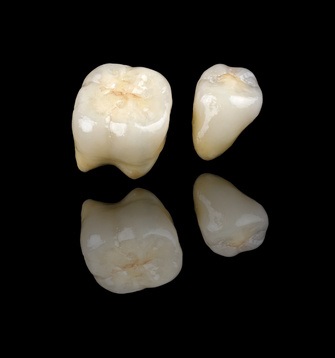Bring back your smile with a Crown and Bridge
What is a Crown?
In the same way that you may wear a crown on the top of your head, a dental crown is the part of the tooth that sits on top of the root of the tooth. The crown is what you see when you smile or what you actually chew with.
When is a Crown used?
As we age, many of us find ourselves with teeth that are no longer structurally sound. Root canals, lost fillings, decay, chipping, and cracking of the enamel are all things that can lead to large-scale problems in a tooth’s surface. When the entire surface of the tooth is a problem, but the root system is intact, a crown might be the ideal solution for you.
A crown is used in both restorative and cosmetic dental procedures. It is normally used to restore teeth that have been damaged, decayed or fractured. Miraculously, a crown also assists in bringing back your beautiful smile.
What is a Crown made of?
A crown can be made from a few different materials. Direct composite resin, full porcelain crown, porcelain fused-to-metal crown and the all-metal crown are examples of materials used for crowns. The most common being porcelain due to its function and ability to act as your natural teeth do. When an individual treatment plan is designed for you and if crowns are part of that, your dentist will discuss with you the best material to use for your circumstances.
How can a Crown help my smile?
Often referred to as ‘caps’, crowns are coverings for the entire visible part of the tooth. They become necessary when teeth are broken, old and large fillings are lost, teeth have fractured, chipped or are sensitive. Crowns improve the appearance of your natural teeth and can brighten your smile if you teeth are dull or discoloured. A crown can also be used to protect a weakened root-treated tooth.
How can teeth become damaged?
Grinding your teeth, an improper bite, age and tooth decay can all be contributing factors in the wearing down, cracking or breakage of your teeth. Dental crowns provide strength, durability and tooth stability. In other instances, crowns are used to replace a missing tooth. These crowns are anchored to the teeth on either side of the space, with a bridge section connecting the two crowns.
Advantages and disadvantages of a Crown
Advantage: Porcelain is considered the most aesthetically pleasing option, as it is so easily matched in colour to your surrounding teeth.
Disadvantage: The thickness of the porcelain required for pleasing aesthetics also requires that more tooth structure needs to be removed. It is more difficult for us to get an ideal fit where your gum meets the crown. If it does not work for your particular dental health, you may consider veneers as a solution.
Conditions that benefit from Crowns
You may find that if you are suffering from one of the following conditions, a crown could be a suitable solution for you.
- A previously filled tooth where there now exists more filling than tooth. This will cause the existing tooth structure to become weaker and no longer support the remaining filling.
- Extensive damage by decay.
- Discolorations and an aesthetic appearance you are unhappy with.
- Fractures in your teeth.
- Bridges – When missing teeth are replaced with a bridge, usually the adjacent teeth require crowns in order to support the replacement teeth.
How many appointments do I need for a Crown?
Constructing a crown requires two appointments. During your first visit, the tooth is prepared for the crown, an impression mould is made and a temporary crown is placed over the prepared tooth. At your subsequent visit, the temporary crown is removed and the final crown is fitted, adjusted and secured into place – simple!
What is a Bridge?
A dental bridge is a new tooth, which is connected to the adjacent teeth. The new teeth can be:
- bonded directly to adjacent teeth with minimum or no tooth structure loss
- bonded to adjacent teeth with special cast connectors with minimum tooth structure loss
- bonded or cemented to adjacent teeth which have been prepared to receive full crowns (as above)
When is a Bridge used?
This procedure is used to replace one or more missing teeth. Bridges are fixed and cannot be taken out of your mouth as you might do with removable partial dentures. If spaces are left unfilled, they may cause the surrounding teeth to drift out of position.
What is the process to get a Bridge?
After your teeth and needs have been assessed, the appropriate diagnostic records and models taken, the required structure of the bridge is decided upon. Bridges offer a functional way to replace missing teeth and work hand in hand with crowns to achieve the best possible aesthetically pleasing effect.
If you have missing teeth and have good oral hygiene practices, you should discuss this procedure with your Collins Dental Centre dentist. Book an appointment on (03) 6224 3575
Call: (03) 6224 3575
158 Collins Street, Hobart
Office Hours
Monday – Friday 8.45am-5.15pm
Send an Email
collinsdentalcentre@gmail.com

